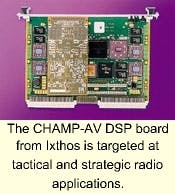By John McHale
LEESBURG, Va. -- Ixthos officials claim their new VME CHAMP-AVa digital signal processor (DSP) board, based on the Motorola AltiVec chip, can function as a rugged, conduction-cooled digital radio.
It is the first digital radio in the industry to come in a rugged version, claims Doug Patterson, director of marketing at Ixthos in Leesburg, Va. Engineers at DY 4, the Ixthos parent company in Kanata, Ontario, ruggedize the device, he adds.
The CHAMP-AV (common heterogeneous architecture for multiprocessing) "is ideal for tactical and strategic radio programs for joint services," Patterson says. Patterson declined to comment on specific applications for contractual reasons.
The board's high-throughput concurrent multiprocessing architecture can run at 14.4 billion floating point operations per second (GFLOPS) in one 6U VME slot. The device provides support for two PMC expansion modules, which enables the board to function as a digital radio, Patterson says.
The board generates greater performance than earlier versions and has independent data paths that give each PMC node dedicated data paths for performing Fast Fourier Transforms and other intensive signal-processing functions, Patterson explains.
Several independent data bridges separate the internal primary and secondary data paths to provide more than 1 gigabyte per second simultaneous I/O data movement throughout the board and for concurrent I/O and VMEbus transfers. An MPC107 Chaparral Northbridge supports dual DMA and Port X memory interfaces for local 32/66 data transfers.
The CHAMP-AV DSP board from Ixthos is targeted at tactical and strategic radio applications.
The CHAMP-AV follows the CHAMP-C6, designed with the TI TMS320C6x fixed- and floating-point processors. The CHAMP-AV supports multiple high-speed, high-performance versions of the PowerPC G3 750 and G4 AltiVec processors from Motorola, and provides two on-board, industry-standard, 64 bit/66 MHz PCI mezzanine card (PMC) sites with I/O expansion handled to and from the front panel, or over the P0 or P2 backplane connectors.
The PMCs offer open, industry-standard connections to real-world analog and digital I/O, high-speed serial, or multi-protocol interconnect fabrics, which target the CHAMP-AV at high-throughput data applications such as radar, sonar, signals intelligence, and image processing, Ixthos officials claim.
Global memory for the CHAMP-AV is 32 to 64 megabytes of high-speed SDRAM, 64 bits wide. Local memory is also SDRAM, with 32 to 64 megabytes per MPC750 PowerPC or MPC7400 AltiVec PowerPC pair. L2 cache is as large as 2 megabytes of synchronous burst SRAM per MPC7400 AltiVec PowerPC, and flash memory as large as 16 megabytes is also available for the board.
CHAMP-AV software support includes the IXATools from Ixthos to configure the DSP and provide a suite of DSP libraries. This suite includes host/target support libraries and Smart DMA firmware which presents a command interface to the VMEbus or PowerPCs. Additional DSP libraries come from IXLibs-AV third-party software, including EST JTAG emulator and development tools, and the VxWorks operating system from Wind River Systems in Alameda, Calif.
null

